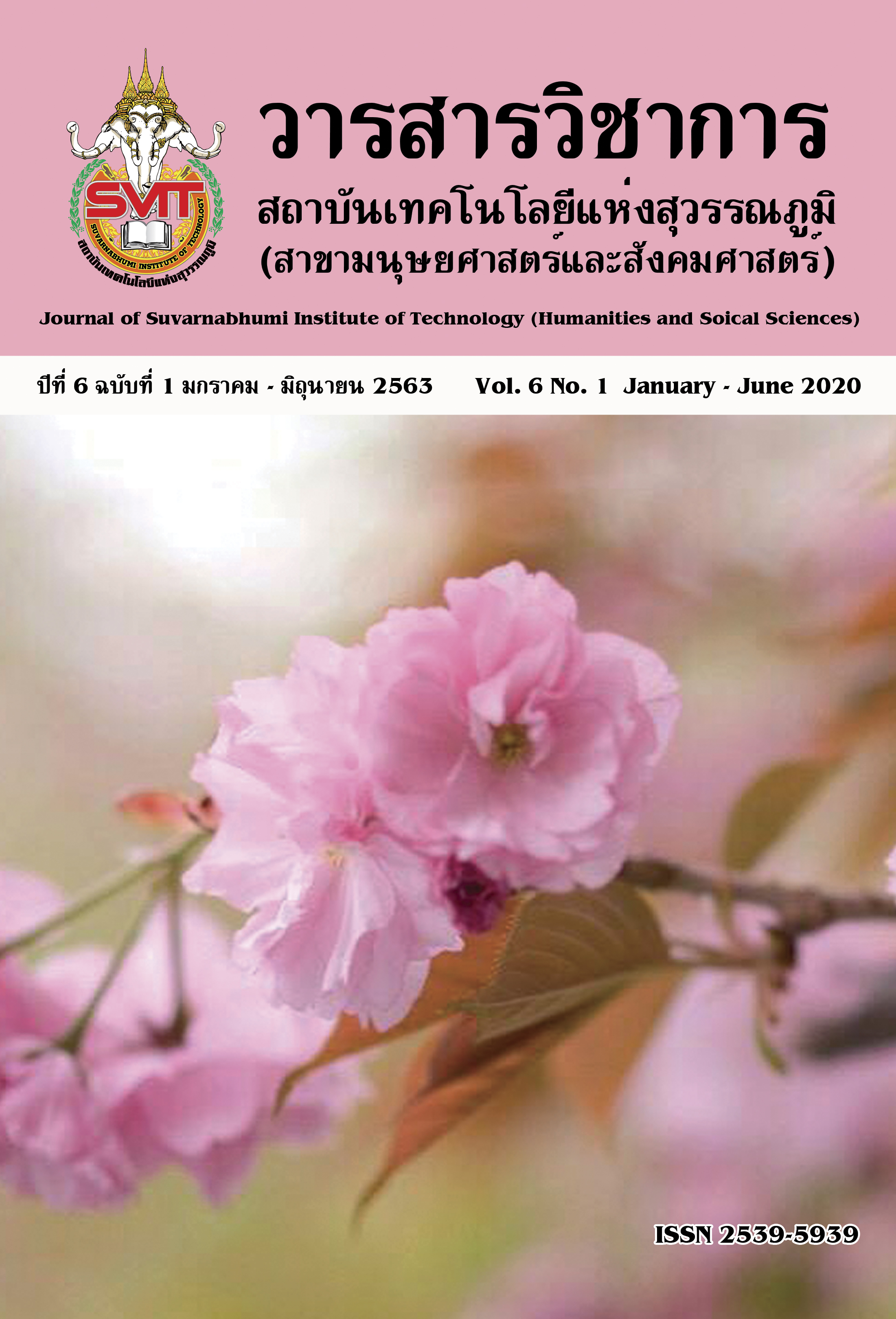CAUSAL RELATIONSHIP MODEL OF PURCHASING INTENTION OF HERBAL COSMETIC PRODUCT VIA FACEBOOK OF CONSUMER IN BANGKOK METROPOLITAN REGION
Keywords:
Facebook, Intention, Customer Loyalty, Herbal Cosmetics ProductAbstract
The purposes of this research are to develop causal relationship model of purchasing intention of herbal cosmetic product via Facebook of consumer in Bangkok metropolitan region and to check the consistency of a causal relationship model developed based empirical data from respondents’ bunch of 388 people who were selected randomly. The tool of collecting data is the online questionnaire by using structural equation model analysis by a computer program data analysis model to research 6 components which are 1) Information access 2) Bargain perception 3) Experiential shopping 4) Time saving 5) Customers loyalty and 6) Purchase intention.
The findings were as follows: the model is consistent whit the empirical data to a great extent. The statistic shows the Chi-square statistics goodness fit test (c 2) = 369.82 , degrees of freedom (df) = 349 ,CMIN / DF = 1.06, GFI = 0.94, AGFI = 0.92, SRMR = 0.03, RMSEA = 0.01 and the final is the predictive coefficient of 0.97, So the model could explain the variable intention to buying 97 percent with information access, bargain perception, experiential shopping, time saving, loyalty and purchase intention creativity which are combined affecting with the purchase intention to buying herbal cosmetics product on Facebook.
References
กริช แรงสูงเนิน. (2554). การวิเคราะห์ปัจจัย SPSS และ AMOS เพื่อการวิจัย.กรุงเทพฯ: ซีเอ็ดยูเคชั่น.
จักรพันธ์ พวงนาค. (2552). แนวทางการเพิ่มยอดขายนาฬิกาข้อมือ. การค้นคว้าแบบอิสระ บริหารธุรกิจ มหาบัณฑิต, มหาวิทยาลัยเกษตรศาสตร์ กรุงเทพฯ.
จตุพล พงษ์วิทยภานุ. (2554). อิทธิของสังคมออนไลน์ที่มีผลต่อการตัดสินใจซื้อคอนโดมิเนียม.วิทยานิพนธ์ปริญญามหาบัณฑิต, มหาวิทยาลัยธรรมศาสตร์.
ชูศรี วงศ์รัตนะ. (2560). เทคนิคการสร้างเครื่องมือวิจัย : แนวทางการนำไปใช้อย่างมืออาชีพ. กรุงเทพฯ : อมรการพิมพ์.
ชไมพร กาญจนกิจสกุล. (2555). ระเบียบวิธีวิจัยทางสังคมศาสตร์:บริษัท โพรเจ็คท์ ไฟฟ์ขไฟว์ จำกัด
ฐิติกานต์ นิธิอุทัย. (2556).การสร้างแบรนด์ให้ติดตลาดด้วย Facebook.(หน้า10-11).กรุงเทพ:บริษัทอินส์พลจำกัด.
ฐิติกานต์ นิธิอุทัย. (2553). Facebook Marketing. กรุงเทพฯ : ดรีม แอนด์ แพชชั่น
ธานินทร์ ศิลป์จารุ. (2555).การวิจัยและวิเคราะห์ข้อมูลทางสถิติด้วย SPSS และ AMOS (พิมพ์ครั้งที่ 13).
กรุงเทพฯ: บิสซิเนส อาร์แอนด์ดี.
นงลักษณ์ วิรัชชัย. (2542). โมเดลลิสเรล: สถิติวิเคราะห์สำหรับการวิจัย (พิมพ์ครั้งที่ 3).กรุงเทพฯ: โรงพิมพ์แห่งจุฬาลงกรณ์มหาวิทยาลัย.
บุษรา ประกอบธรรม. (2555). การศึกษาการรับเครือข่ายสังคมออนไลน์ของนักศึกษา: กรณีศึกษามหาวิทยาลัยกรุงเทพ. วารสารสุทธิปริทัศน์. 27(81), 93-108.
ภิเษก ชัยนิรันดร์. (2553). การตลาดแนวใหม่ผ่าน social media. (หน้า 37-44). กรุงเทพฯ:ซีเอ็ดยูเคชั่น.
สำนักงานพัฒนาธุรกรรมทางอิเล็กทรอนิกส์. (2560). รายงานผลสำรวจมูลค่าพาณิชย์อิเล็กทรอนิกส์ในประเทศไทยปี 2560. กรุงเทพฯ: สำนักงานพัฒนาธุรกรรมทางอิเล็กทรอนิกส์.
สุนทร ตรีนันทวัน. (2555). ภาวะโลกร้อนกับอุทกภัย.เรื่องเด่นประจำวันอุทกภัย, 40(176), 10-13.
อัยรดา พรเจริญ. (2550). องค์ประกอบที่มีอิทธิพลต่อความตั้งใจซื้อสินค้าทางอินเทอร์เน็ต (รายงานผลการวิจัย). อุบลราชธานี: มหาวิทยาลัยราชภัฏอุบลราชธานี
Anderson, K. C., Knight, D. K., Pookulangara, S., & Josiam, B. (2014). Influence of Hedonicand Utilitarian motivations on retailer loyalty and purchase intension: A Facebook perspective. Unpublished master’s thesis, University of NorthTexas, TX
Kelley, C. A. & Dee, K. Knight.(2014). Influence of hedonic and utilitarian motivations on retailer
loyalty and purchase intention: a facebook perspective. Journal of Retailing and Consumer Services, 21, 733-779
Kotler, P. (2000). Marketing Management. (10th ed.) New Jersey: Pretice-Hall, Inc.
Kwon, K., & Jain, D. (2009). Multichannel shopping through nontraditional retail formats: variety seeking-behavior with hedonic and utilitarian motivations. J.Market. Channels
Wertime, K. & Fenwick, I. (2008). DigiMarketing: the essential guide to new media & digital markeing. Singapore: John Wiley & Sons, Inc.
Downloads
Published
Issue
Section
License
Copyright (c) 2020 Suvarnabhumi Institute of Technology

This work is licensed under a Creative Commons Attribution-NonCommercial-NoDerivatives 4.0 International License.
บทความที่ได้รับการตีพิมพ์เป็นลิขสิทธิ์ของวารสารวิชาการ สถาบันเทคโนโลยีแห่งสุวรรณภูมิ
ข้อความที่ปรากฏในบทความแต่ละเรื่องในวารสารวิชาการเล่มนี้เป็นความคิดเห็นส่วนตัวของผู้เขียนแต่ละท่านไม่เกี่ยวข้องกับสถาบันเทคโนโลยีแห่งสุวรรณภูมิ และคณาจารย์ท่านอื่นๆในสถาบันฯ แต่อย่างใด ความรับผิดชอบองค์ประกอบทั้งหมดของบทความแต่ละเรื่องเป็นของผู้เขียนแต่ละท่าน หากมีความผิดพลาดใดๆ ผู้เขียนแต่ละท่านจะรับผิดชอบบทความของตนเองแต่ผู้เดียว





